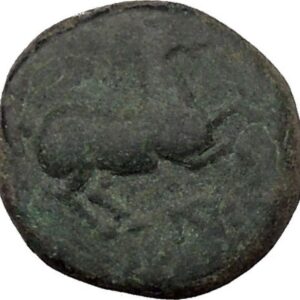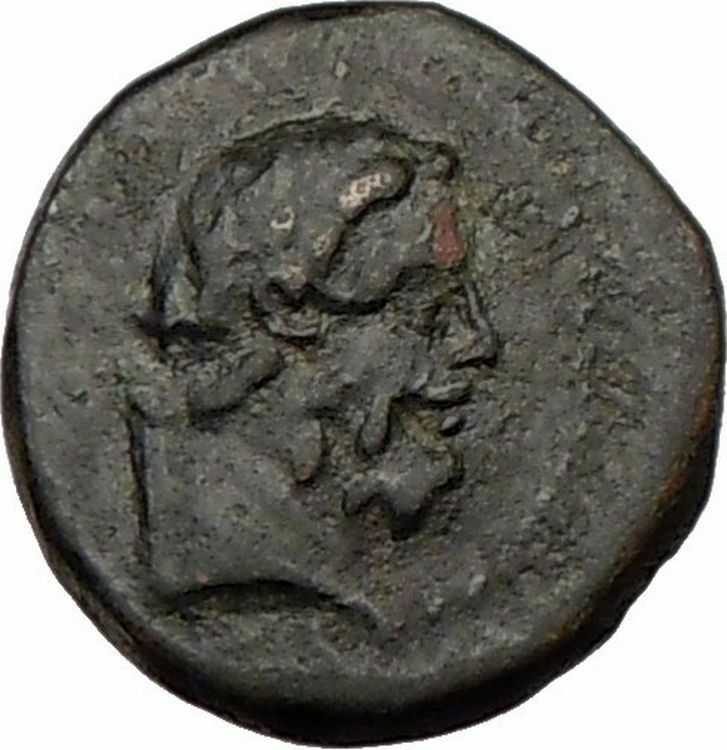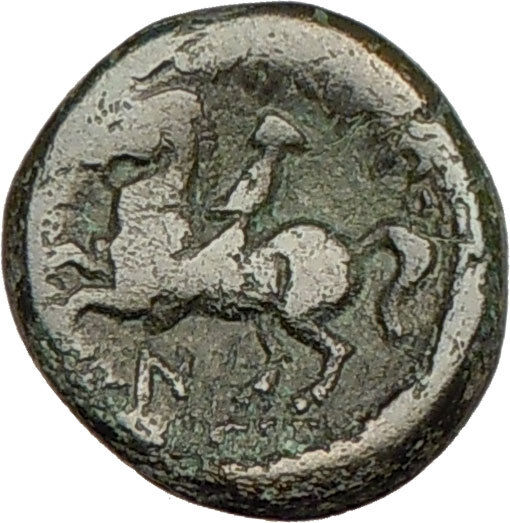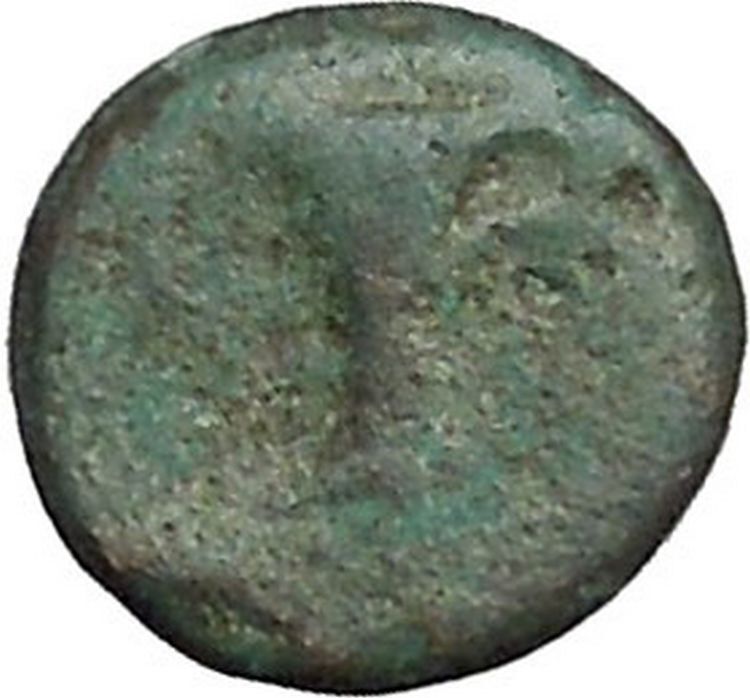|
Greek Coin of Seleukid Kingdom
Antiochos IV, Epiphanes – King: 175-164 B.C.
Bronze 14mm of Perhaps Europs (Doura) mint.
Reference: HGC 9, 695 Rare R2; SC 1434
Certification: NGC Ancients VF 5285281-074
Radiate and diademed head of Antiochos IV right.
ΒΑΣΙΛΕΩΣ ΑΝΤΙΟΧΟY / ΘΕΟΥ ΕΠΙΦΑΝΟΥΣ, Apollo seated left on omphalos, holding arrow and grounded bow.
King Antiochus IV, Epiphanes of the Seleucid Kingdom reigned 175-164 B.C. Younger son of Antiochus the Great, Antiochus IV seized the Seleucid throne in 175 B.C. after having spent the previous twelve years as a hostage in Rome. He was a vigorous ruler and attempted to extend Seleucid influence by invading Egypt, though he was obliged to withdraw because of the Roman opposition. He was also aroused the hatred of the Jews by despoiling the Temple in Jerusalem and later tearing down the city walls. Antiochus died on campaign in the east in 164 B.C.
You are bidding on the exact item pictured, provided with a Certificate of Authenticity and Lifetime Guarantee of Authenticity.
 Antiochus IV Epiphanes (“Manifest (God)“, “the Illustrious” born c. 215 BC; died 163 BC) ruled the Seleucid Empire from 175 BC until his death in 163 BC. He was a son of King Antiochus III the Great and the brother of Seleucus IV Philopator. His original name was Mithridates; he assumed the name Antiochus after he assumed the throne. Antiochus IV Epiphanes (“Manifest (God)“, “the Illustrious” born c. 215 BC; died 163 BC) ruled the Seleucid Empire from 175 BC until his death in 163 BC. He was a son of King Antiochus III the Great and the brother of Seleucus IV Philopator. His original name was Mithridates; he assumed the name Antiochus after he assumed the throne.
Notable events during the reign of Antiochus IV include his near-conquest of Egypt, which led to a confrontation that became an origin of the metaphorical phrase, “line in the sand” (see below), and the rebellion of the Jewish Maccabees.
He assumed divine epithets, which no other Hellenistic king had done, such as Theos Epiphanes (Greek: ΘΕΟΣ ΕΠΙΦΑΝΗΣ mean “God Manifest”) and after his defeat of Egypt, Nikephoros (Greek: ΝΙΚΗΦΟΡΟΣ mean “Bearer of Victory”). But his often eccentric behavior, capricious actions and even insanity led some of his contemporaries to call him Epimanes (“The Mad One”), a word play on his title Epiphanes.
Rise to Power
As the son and a potential successor of King Antiochus III, Antiochus became a political hostage of the Roman Republic following the Peace of Apamea in 188 BC. When his older brother, Seleucus IV followed his father onto the throne in 187 BC, Antiochus was exchanged for his nephew Demetrius I Soter (the son and heir of Seleucus). After King Seleucus was assassinated by Heliodorus, an usurper, in 175 BC, Antiochus in turn ousted him. Since Seleucus’ legitimate heir, Demetrius I Soter, was still a hostage in Rome, Antiochus, with the help of King Eumenes II of Pergamum, seized the throne for himself, proclaiming himself co-regent for another son of Seleucus, an infant named Antiochus (whom he then murdered a few years later).
Wars against Egypt
Main article: Sixth Syrian War
When the guardians of King Ptolemy VI of Egypt demanded the return of Coele-Syria in 170 BC, Antiochus launched a preemptive strike against Egypt, conquering all but Alexandria and capturing King Ptolemy. To avoid alarming Rome, Antiochus allowed Ptolemy VI to continue ruling as a Puppet-king. Upon Antiochus’ withdrawal, the city of Alexandria chose a new King, one of Ptolemy’s brothers, also named Ptolemy (VIII Euergetes). Instead of fighting a civil war, the Ptolemy brothers agreed to rule Egypt jointly.
In 168 BC Antiochus led a second attack on Egypt and also sent a fleet to capture Cyprus. Before reaching Alexandria, his path was blocked by a single, old Roman ambassador named Gaius Popillius Laenas, who delivered a message from the Roman Senate directing Antiochus to withdraw his armies from Egypt and Cyprus, or consider themselves in a state of war with the Roman Republic. Antiochus said he would discuss it with his council, whereupon the Roman envoy drew a line in the sand around him and said, “Before you cross this circle I want you to give me a reply for the Roman Senate” – implying that Rome would declare war if the King stepped out of the circle without committing to leave Egypt immediately. Weighing his options, Antiochus decided to withdraw. Only then did Popillius agree to shake hands with him.
Sacking of Jerusalem and Persecution of Jews
While Antiochus was busy in Egypt, a rumor spread that he had been killed. The deposed High Priest Jason gathered a force of 1,000 soldiers and made a surprise attack on the city of Jerusalem. The High Priest appointed by Antiochus, Menelaus, was forced to flee Jerusalem during a riot. On the King’s return from Egypt in 167 BC enraged by his defeat, he attacked Jerusalem and restored Menelaus, then executed many Jews.
| “ |
When these happenings were reported to the king, he thought that Judea was in revolt. Raging like a wild animal, he set out from Egypt and took Jerusalem by storm. He ordered his soldiers to cut down without mercy those whom they met and to slay those who took refuge in their houses. There was a massacre of young and old, a killing of women and children, a slaughter of virgins and infants. In the space of three days, eighty thousand were lost, forty thousand meeting a violent death, and the same number being sold into slavery. |
“ |
| |
– 2 Maccabees 5:11-14
|
To consolidate his empire and strengthen his hold over the region, Antiochus decided to side with the Hellenized Jews by outlawing Jewish religious rites and traditions kept by observant Jews and by ordering the worship of Zeus as the supreme god.[citation needed] This was anathema to the Jews and when they refused, Antiochus sent an army to enforce his decree. Because of the resistance, the city was destroyed, many were slaughtered, and a military Greek citadel called the Acra was established.
| “ |
Not long after this the king sent an Athenian senator to force the Jews to abandon the customs of their ancestors and live no longer by the laws of God; also to profane the temple in Jerusalem and dedicate it to Olympian Zeus, and that on Mount Gerizim to Zeus the Hospitable, as the inhabitants of the place requested…They also brought into the temple things that were forbidden, so that the altar was covered with abominable offerings prohibited by the laws. A man could not keep the sabbath or celebrate the traditional feasts, nor even admit that he was a Jew. At the suggestion of the citizens of Ptolemais, a decree was issued ordering the neighboring Greek cities to act in the same way against the Jews: oblige them to partake of the sacrifices, and put to death those who would not consent to adopt the customs of the Greeks. It was obvious, therefore, that disaster impended. Thus, two women who were arrested for having circumcised their children were publicly paraded about the city with their babies hanging at their breasts and then thrown down from the top of the city wall. Others, who had assembled in nearby caves to observe the sabbath in secret, were betrayed to Philip and all burned to death. |
“ |
| |
– 2 Maccabees 6:1-11
|
Rebellion of the Maccabees
Jewish historical documents near the time of the event (1 Macc, written c. 135 BC; 2 Macc, written c. 124 BC) painted the Maccabean Revolt as a national resistance of a foreign political and cultural oppression.
Modern scholars argue that the king was intervening in a civil war between the traditionalist Jews in the country and the Hellenized Jews in Jerusalem. According to Joseph P. Schultz:
Modern scholarship on the other hand considers the Maccabean revolt less as an uprising against foreign oppression than as a civil war between the orthodox and reformist parties in the Jewish camp.
It seems that the traditionalists, with Hebrew/Aramaic names like Onias, contested with the Hellenizers with Greek names like Jason and Menelaus over who would be the High Priest. Other authors point to possible socio/economic motives in addition to the religious motives behind the civil war.
What began in many respects as a civil war escalated when the Hellenistic kingdom of Syria sided with the Hellenizing Jews in their conflict with the traditionalists. As the conflict escalated, Antiochus took the side of the Hellenizers by prohibiting the religious practices that the traditionalists had rallied around. This may explain why the king, in a total departure from Seleucid practice in all other places and times, banned the traditional religion of a whole people.
Final years
Taking advantage of Antiochus’ western problems, King Mithridates I of Parthia attacked from the east and seized the city of Herat in 167 BC, disrupting the direct trade route to India and effectively splitting the Greek world in two.
Recognizing the potential danger in the east, but unwilling to give up control of Judea, Antiochus sent a commander named Lysias to deal with the Maccabees, while the King himself led the main Seleucid army against the Parthians. After initial success in his eastern campaign, including the reoccupation of Armenia, Antiochus died suddenly of disease in 163 BC.
Legacy of Antiochus IV
The reign of Antiochus was the last period of real strength for the Seleucid Dynasty, but in some ways his rule was also fatal to the Empire. Technically Antiochus IV was a usurper, and he left an infant son named Antiochus V Eupator as his only heir. The result was a series of civil wars between rival claimants to the throne, effectively crippling the Empire during a critical phase in the wars against Parthia.
In Jewish tradition
Antiochus IV ruled the Jews from 175-163 BC. He is remembered as a major villain and persecutor in the Jewish traditions associated with Hanukkah, including the books of Maccabees and the “Scroll of Antiochus”. Rabbinical sources refer to him as הרשע harasha (“the wicked”).
Claimed to be described in Prophetic Writings of Daniel
The Preterist interpretation of Daniel 8 holds that Antiochus IV appears in the prophetic writings of the book of Daniel (dated 536 BC) despite compelling evidence to the contrary (described below). Daniel 8 describes “the little horn” that grows from one of the four horns atop the male goat (Daniel 8:9). Preterists cite as evidence that Antiochus IV represents the “little horn” the fact that the male goat represents the Greek empire under the rule of Alexander the Great. The four horns that then grow (Daniel 8:8) are the four divisions of the Greek Empire that formed after Alexander’s death: the Ptolemaic kingdom of Egypt, the Seleucid Empire in the east, the Kingdom of Pergamon in Asia Minor, and Macedon. The “little horn” grew out of one of the four horns, which Preterists believe is the Seleucid Empire and expanded further east, south and west according to the prophecy. Preterists also hold that Daniel 8:10-14 describes Antiochus’ dealings with the Jewish people under his rule which ended with the Maccabean Revolt.
The Historicist interpretation of Daniel 8 proposes that the little horn represents Rome and not Antiochus IV. In the prophecy of Daniel 8 the following descriptions are used to identify each power:
| Power – Symbol |
Preterist view |
Historicist view |
| Great – Ram Daniel 8:4 |
Medo Persia |
Medo Persia |
| Very Great – Goat Daniel 8:8 |
Greece |
Greece |
| Exceeding Great – Little Horn Daniel 8:9-10 |
Antiochus IV (8th in line of 26 Seleucid Kings) |
Rome |
It is important to note that the Little Horn power according to the progression shown in Daniel 8 will have more influence and dominion than did the Persian Empire which controlled from India to Ethiopia (Esther 1:1) and Alexander the Great who conquered the then known world before the age of 32. The historical evidence shows that the exploits of Antiochus Epiphanes is lacking in this regard.
The little horn was also to “stand up against the prince of princes” Daniel 8:25. That the prince of princes represents Jesus Christ is of little dispute (Revelation 1:5, Revelation 17:14, Revelation 19:16). Antiochus IV died some 160 years before Jesus Christ was born. Rome, however was the dominant power that held sway during the attempt to kill Christ as a child (Herod) and His crucifixion (Acts 4:26-27).
That the little horn is “broken without hands” (Daniel 8:25) seems to be a reference to the events described in (Daniel 2:34) where a stone “cut out without hands” strikes the statue at the feet representing the divided kingdoms of Rome.
Antiochus IV also paid tribute to Rome. The power that is described as “exceeding great” would most likely be the power collecting a tribute rather than paying one.
<span class="mw-headline" id="Early_wars_against_other_Hellenistic_rulers" early ="" wars="" against="" other="" hellenistic="" rulers
 The Seleucid Empire was a Hellenistic state ruled by the Seleucid dynasty founded by Seleucus I Nicator following the division of the empire created by Alexander the Great. Seleucus received Babylonia and, from there, expanded his dominions to include much of Alexander’s near eastern territories. The Seleucid Empire was a Hellenistic state ruled by the Seleucid dynasty founded by Seleucus I Nicator following the division of the empire created by Alexander the Great. Seleucus received Babylonia and, from there, expanded his dominions to include much of Alexander’s near eastern territories.
The Seleucid Empire was a major center of Hellenistic culture that maintained the preeminence of Greek customs where a Greek-Macedonian political elite dominated, mostly in the urban areas. The Greek population of the cities who formed the dominant elite were reinforced by emigration from Greece. Seleucid expansion into Anatolia and Greece was abruptly halted after decisive defeats at the hands of the Roman army. Their attempts to defeat their old enemy Ptolemaic Egypt were frustrated by Roman demands. Much of the eastern part of the empire was conquered by the Parthians under Mithridates I of Parthia in the mid-2nd century BC, yet the Seleucid kings continued to rule a rump state from the Seleukid Kingdom until the invasion by Armenian king Tigranes the Great and their ultimate overthrow by the Roman general Pompey.
|









 Antiochus IV Epiphanes (“Manifest (God)“, “the Illustrious” born c. 215 BC; died 163 BC) ruled the Seleucid Empire from 175 BC until his death in 163 BC. He was a son of King Antiochus III the Great and the brother of Seleucus IV Philopator. His original name was Mithridates; he assumed the name Antiochus after he assumed the throne.
Antiochus IV Epiphanes (“Manifest (God)“, “the Illustrious” born c. 215 BC; died 163 BC) ruled the Seleucid Empire from 175 BC until his death in 163 BC. He was a son of King Antiochus III the Great and the brother of Seleucus IV Philopator. His original name was Mithridates; he assumed the name Antiochus after he assumed the throne. The Seleucid Empire was a Hellenistic state ruled by the Seleucid dynasty founded by Seleucus I Nicator following the division of the empire created by Alexander the Great. Seleucus received Babylonia and, from there, expanded his dominions to include much of Alexander’s near eastern territories.
The Seleucid Empire was a Hellenistic state ruled by the Seleucid dynasty founded by Seleucus I Nicator following the division of the empire created by Alexander the Great. Seleucus received Babylonia and, from there, expanded his dominions to include much of Alexander’s near eastern territories.




